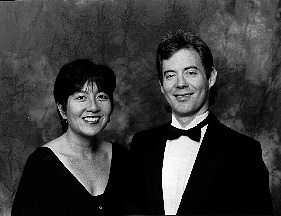|
(U.S.A.)
|
 |
||||
|
|||||
| The Bleuel Duo
John Bleuel and Linda Li-Bleuel have performed together since 1990. They have performed on the Bridge New Music Series at Lincoln Center, the Eleventh World Saxophone Congress in Valencia, Spain, the l 999 International Meeting of the College Music Society in Kyoto, Japan, the 1998 International Women Composers Festival, and the 1997 International Meeting of the College Music Society in Vienna, Austria. They premiered Lewis Nielson's There is a Gate on the Music from Almost Yesterday concert series in Milwaukee in March, 1999, were featured on a concert of new music at the 199 National Meeting of the College Music Society, and have presented recitals and master classes at numerous universities. Their recordings of Dan Maske's Far Corner and Jay Vosk's Notturno are featured on the Arizona University Recordings cd series "America's Millennium Tribute to Adolphe Sax." John Bleuel has taught at the University of West Georgia, Georgia Southern University, and the University of Wisconsin-Milwaukee. He earned the DMA in saxophone performance at the University of Georgia, the MM in instrumental conducting from the University of Wisconsin-Milwaukee, and the BM in saxophone performance from the University of Wisconsin-Oshkosh. His major teachers were Kenneth Fischer (saxophone) and Thomas Dvorak (conducting). Linda Li-Bleuel is an Assistant Professor of Music at Clemson University, and has previously taught at Georgia Southern University and Carroll College. She earned the DMA at the Universit, of Georgia, the MM at the University of Wisconsin, and the BM from the University of Illinois. She studied with Jane Allen Kenneth Drake, and Richard Zimdars. |
|||||
There is a Gate |
|||||
| There is a Gate was written for and dedicated to John Bleuel and Linda Li-Bleuel
The three main sections of the work correspond to part of an enigmatic inscription on a bridge at the Summer Palace of the former emperors of China, north of Beijing. A translation of the full inscription reads: There are three monkeys who cannot see their faces.
The contradiction of the images in the inscription have a clear general meaning but also some rather striking implications for the medium of music. I did not intend that the sections of the work would be very distinct from one another. The three main phases of activity (the ebb and flow of the accumulation/diminution of texture and notes of section 1; the cold melody of the alto saxophone of section 2; the recurrence of the accumulation/receding material of the alto saxophone grouped around and insistent, repeating chord in piano, terminating in an enigmatic coda in section 3) are written to and should be performed so that they flow almost imperceptibly into each other. The greatest suppleness of phrasing is encouraged despite the apparent rigidity and strictness of the rhythmic texture. – Lewis Nielson |
|||||
|